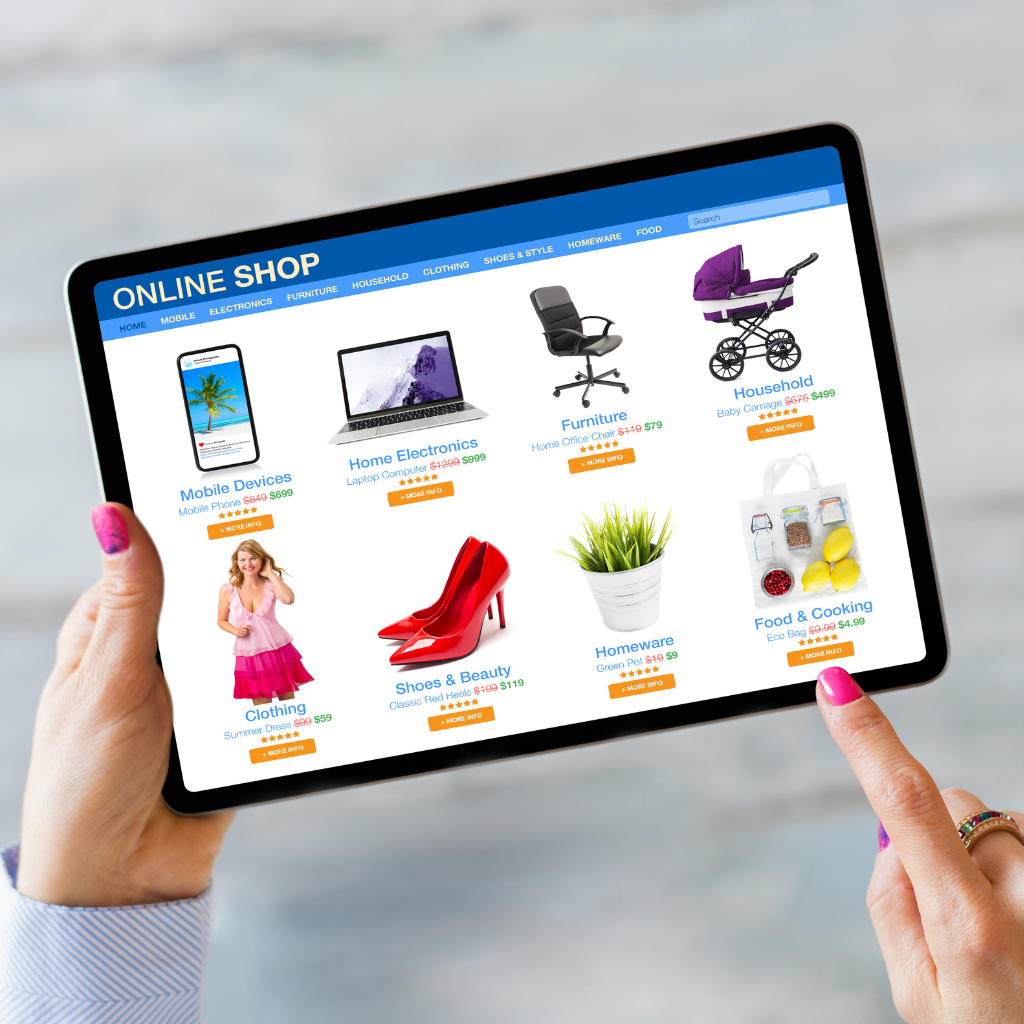The recent years have seen the increasing access to mobile devices and the rise in online retail. It’s no wonder that the share of eCommerce in global retail sales is predicted to grow continuously to 21.8 percent (equivalent to approximately $6.388 trillion) in 2024. In parallel, increasing demand for eCommerce site design is rising also. To make websites more user-friendly and accessible to interested customers, companies must look for eCommerce website Design Company or services that can satisfy the requirements of their customers.
What Are eCommerce Design Services For Websites?
The first part will dive into the world of web design for eCommerce and development services, providing a better understanding of what they are and why they are so crucial for businesses that operate within the B2C eCommerce landscape. Let’s look at the art and science behind creating websites that meet the requirements and preferences of the modern-day online buyer.
Defines eCommerce Website Design Services
- eCommerce Website design services cover the process of designing online platforms that are specifically designed for businesses involved with B2C Ecommerce. These services include creating online spaces that allow your web design company california to display their services or products to prospective customers.
- With eCommerce website design services, professionals use different elements like layout and color schemes, typography, and user interfaces to create visually appealing and user-friendly sites.
- These services are essential in enhancing the site’s performance, ensuring fast loading times and responsiveness to mobile devices.
- At the core, eCommerce website design services involve more than aesthetics. They aim to create an online experience that is not just a magnet for buyers but also assists in the buying process, from browsing to checkout. This holistic approach is crucial in the highly competitive market that is B2C Ecommerce, where user satisfaction is a significant factor in the business’s performance.
The Importance Of Attractive And User-Friendly eCommerce Websites

- First, websites are powerful instruments for engaging users efficiently. Studies show that if given a 15-minute period to read content, two-thirds prefer engaging with beautifully constructed websites instead of simple websites. The appealing visuals entice users and engage them in their online shopping experience.
- Additionally, the significance of a user-friendly interface extends to the retention of customers. An effective user interface can boost the conversion rates of a website by 200 percent. A poor user experience can turn away potential users, with 90% of users not likely to revisit a site simply because of poor UX. This underscores the direct effect of a website’s design on its capacity to keep its users.
- Furthermore, visually appealing and user-friendly websites play a significant role in encouraging the growth of businesses. A professional look and accessibility encourage customers to continue exploring the website, which leads to increased interaction with the company and, more likely, conversion. In today’s competitive market in B2C Ecommerce, these factors are crucial to the business’s success.
- To demonstrate the importance of a user-friendly, visually appealing design, look at some examples from famous brands. Spotify’s choice of a simple black-and-white style featuring vibrant images, Apple’s timeless black-and-gray design, Lush’s contemporary black-and-white theme, and Warby Parker’s use of whitespace illustrate how well-designed choices can improve the overall experience for users and enhance the performance for an online store.
What Are The Differences Between B2B And B2C eCommerce Website Designs?
1. Customer intent
Customer expectations, or the fundamental motives that drive buying decisions made by B2B and B2C buyers, differ.
The goal of B2B eCommerce websites is to make it easier for companies whose purchasing decisions must meet the needs of a diverse group of individuals. These buyers take some time to create more specific specifications for assessing the product and then thoroughly research these requirements. This is why B2B online retailers target top-of-the-funnel as well as middle-of-the-funnel leads. These portals aim to convert these potential customers to customers using inbound (phone consultations or purchases of media) and outbound (content and paid searches) marketing methods.
In the meantime, B2C purchasers act on their personal preferences and feelings. They enjoy browsing to evaluate pricing and features. Thus, you will see a drop in the time sales reps spend contacting customers. In addition, the relationships with B2C suppliers will likely be less frequent than with B2B counterparts because B2C customers’ preferences are driven by cognitive motivations such as scarcity bias, promotions, social proof, etc. That is why B2C websites implement strategies to optimize their conversion rates.
2. Process of purchasing
The B2B purchasing activities involve multiple participants from different departments, purchasing units, and end-users. Web DesignCompanies aim to generate more than immediate sales and increase leads. So, eCommerce websites usually feature the business aspect of content advertising assets (e.g., videos, emails, etc.), as well as interactive tools to define how products and services align with clients’ requirements.

Contrastingly to the other, the B2C eCommerce website design facilitates the exploration of products and creates a feeling of urgency among individuals. They can purchase products they believe to be good bargains or grab something highly rated by other shoppers.
3. User experience
The B2C and B2B trading platforms aim to enhance the user experiences (UX). However, this is a different matter based on the customer’s intention and purchasing procedure. Based on Nielsen Norman Group, both kinds of websites are based on five distinct UX specifications:
* B2B eCommerce websites should be accompanied by more detailed, varied information to aid in the purchasing process.
*The B2B pricing system is more complex based on the product’s flexibility, variety, and sheer quantities. Additionally, B2B products can be negotiated for discount discounts.
* Content for B2B must be tailored to the needs of decision-makers and the end-users.
* The requirements and information of B2B products should be clearly stated so buyers know if they are compatible with their current workflows and processes.
* B2B online retailers serve various business customers in size, industry, and operating budget. This means that B2B navigation on the site should be based on customer segmentation.
Benefits Of BigCommerce To Web Design
Built-in features in the software’s cloud engine aid the design of eCommerce websites. There are four main advantages of using BigCommerce to create a virtual shop is a good option
1. Design doesn’t compromise other attributes.
Through the BigCommerce platform, it is possible to set up an attractive website without worrying about compromising its security, functionality, and ability to scale. No matter if you want a small “building” instead of a luxurious mansion, this scalable solution allows you to customize your back end to fit your essential business functions and your online operation. To do this, BigCommerce provides outstanding properties like SEO-friendly codebases, enhanced data backup, a scalable catalog API, and many more.
With the terminal for clients, you can quickly create an eCommerce site with a distinct user interface. Storefront design tools, including the page builder that doesn’t require code, appealing templates, and more, can ensure that your website is more responsive and consistent with your brand.
2. Many (very excellent) eCommerce themes
If the interior design differs from your style, You can pick from more than 150 themes on Big Commerce’s BigCommerce store is recommended. The templates are responsive to mobile devices, SEO-friendly, and simple. You can refer to the top suggestions from the team. In addition, you can limit your choices by catalog layouts, grid layouts, catalog types, and industries.
3. Opportunities for customization
As an open-SaaS eCommerce platform, BigCommerce allows your online store to seamlessly integrate with other applications (e.g., WordPress and Adobe Experience Management) through APIs and robust data management. This way, the platform will be exposed to a broader range of technological ecosystems.

Additionally, it is worth noting that the eCommerce website design using BigCommerce employs the headless model. This arrangement separates the front-end and back-end capabilities. The server can be changed or updated without impacting the customer’s performance.
4. Simple-to-use tools for building
If you do not know programming, you can quickly create basic yet well-designed web pages using Page Builder. This drag-and-drop editing tool incorporates pre-designed design features and can provide distinct shopping experiences, rapid changes, and advancing digital marketing.
Conclusion
The number of users on the Internet has grown since the beginning of the pandemic. Therefore, the increased demand for effective e-commerce solutions is due to increased online sales. There are many advantages to creating a customized eCommerce website, particularly when you have the most reliable offshore team.
To Read More Tech Blogs Visit: Technical Nick

















